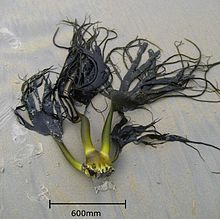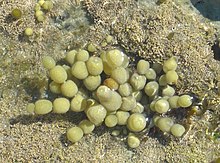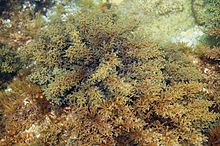Fucales
| Fucales | ||||||||||||
|---|---|---|---|---|---|---|---|---|---|---|---|---|

Fucus distichus , Fucaceae |
||||||||||||
| Systematics | ||||||||||||
|
||||||||||||
| Scientific name | ||||||||||||
| Fucales | ||||||||||||
| Bory |









The Fucales are a species-rich group of brown algae . They include many species known as seaweed .
description
The Fucales comprise macroalgae with real tissue formation, which are usually perennial. The tough, leathery thallus is either forked or irregularly branched. In some species it can be over a meter long. The growth takes place at the ends of the thallus. Some species have swim bladders that provide buoyancy in the water. Types of the intertidal zone are protected from drying out by a layer of mucus ( fucoidin ).
In cell biology, the Fucales are characterized by several scattered discoidal plastids and missing pyrenoids .
Reproduction
The Fucales are graduates without a generation change . In the germ cell containers ( conceptacles ), the gametes arise through meiosis and a different number of mitoses. These few cells created by mitosis correspond to an extremely reduced gametophyte. Immobile egg cells and mobile spermatozoids are almost always formed ( oogamy ). The anterior ciliated flagellum of the spermatozoids is shorter than the smooth posterior flagellum . The spermatozoids are attracted to the egg cells by a pheromone . After fertilization, the zygote settles and grows into a new diploid alga.
Occurrence
The Fucales are common in the seas around the world. They mainly belong to the benthos and grow in the intertidal zone or in the sublittoral on the rock base of the coasts. Some types of golf rods , which are common in warmer seas , also float freely in surface water ( Sargassum natans and Sargassum fluitans ).
Systematics
The Fucales were erected in 1827 by Jean Baptiste Bory de Saint-Vincent . This taxon is the second most species-rich group of brown algae after the ectocarpales . According to Guiry in AlgaeBASE (2014) it comprises 9 sub-taxa (formerly families) with around 528 species. About 337 species belong to the genus of the golf rod ( Sargassum ).
-
Bifurcariopsidaceae Cho, Rousseau, de Reviers & Boo, with only one genus:
-
Bifurcariopsis , with the only species
- Bifurcariopsis capensis (Areschoug) Papenfuss
-
Bifurcariopsis , with the only species
-
Durvillaeaceae (Oltmanns) De Toni, with only one genus:
- Durvillaea Bory de Saint-Vincent, with 5 species including:
-
Fucaceae Adanson, with 6 genera and 26 species:
-
Ascophyllum Stackhouse, with the only kind
- Knotwrack ( Ascophyllum nodosum (L.) Le Jolis)
-
Fucus L., with 18 species, for example
- Sawwrack ( Fucus serratus L.)
- Spiral wrack ( Fucus spiralis L.)
- Bladderwrack ( Fucus vesiculosus L.)
-
Hesperophycus Setchell & Gardner, with the only species
- Hesperophycus californicus PCSilva
-
Pelvetia Decaisne & Thuret, with the only kind
- Channel wrack ( Pelvetia canaliculata (L.) Decaisne & Thuret)
- Pelvetiopsis NLGardner, with 2 species
- Silvetia E. Serrao, TOCho, SMBoo & SHBrawley, with 3 types
-
Ascophyllum Stackhouse, with the only kind
-
Himanthaliaceae (Kjellman) De Toni, with only one genus:
-
Himanthalia Lyngbye, with the only kind
- Kelp ( Himanthalia elongata (L.) SFGray)
-
Himanthalia Lyngbye, with the only kind
-
Hormosiraceae Fritsch, with only one genus:
-
Hormosira (End Lights) Meneghini, with the only kind
- Hormosira banksii (Turner) Decaisne
-
Hormosira (End Lights) Meneghini, with the only kind
-
Notheiaceae OCSchmidt, with only one genus:
-
Notheia Harvey & Bailey, with the only kind
- Notheia anomala Harvey & Bailey
-
Notheia Harvey & Bailey, with the only kind
-
Sargassaceae Kützing, with 31 genera and about 483 species:
- Acrocarpia Areschoug, with 2 species
-
Anthophycus Kützing, with the only species
- Anthophycus longifolius (Turner) Kützing
-
Axillariella PCSilva, with the only species
- Axillariella constricta (J. Agardh) PCSilva
- Bifurcaria Stackhouse, with 2 species
-
Brassicophycus Draisma, Ballesteros, F.Rousseau & T.Thibaut, with the only species
- Brassicophycus brassicaeformis (Kützing) Draisma, Ballesteros, F.Rousseau & T.Thibaut
-
Carpoglossum Kützing, with the only species
- Carpoglossum confluens ( R. Brown ex Turner) Kützing
- Carpophyllum Greville, with 6 species
- Caulocystis Areschoug, with 2 species
-
Cladophyllum Bula-Meyer, with the only species
- Cladophyllum schnetteri Bula-Meyer
-
Coccophora Greville, with the only kind
- Coccophora langsdorfii (Turner) Greville
- Cystophora J. Agardh , with 28 species
-
Cystophyllum J.Agardh, with the only species
- Cystophyllum hildebrandtii Grunow
- Cystoseira C. Agardh, with 37 species
-
Halidrys Lyngbye, with 2 types, among others
- Pod wrack ( Halidrys siliquosa )
-
Hormophysa Kützing, with the only kind
- Hormophysa cuneiformis (JFGmelin) PCSilva
- Landsburgia Harvey, with 3 species
-
Myagropsis Kützing, with the only species
- Myagropsis myagroides (Mertens ex Turner) Fensholt
- Myriodesma Decaisne, with 8 species
-
Nizamuddinia PCSilva, with the only species
- Nizamuddinia zanardinii (Schiffner) PCSilva
-
Oerstedtia Trevisan, with the only kind
- Oerstedtia scalaris (Suhr) Jensen
-
Palaeohalidrys NLGardner, with the only species
- Palaeohalidrys californica NLGardner
- Phyllotricha Areschoug, with 3 species
- Platythalia special, with 2 types
- Polycladia Montagne, with 3 types
- Sargassopsis Trevisan, with 3 species
-
Golftange ( Sargassum C.Agardh), with 337 species, for example
- Sargassum muticum (Yendo) Fensholt
-
Scaberia Greville, with the only kind
- Scaberia agardhii Greville
- Sirophysalis Kützing, with 2 species
- Stephanocystis Trevisan, with 7 species
-
Stolonophora Nizamuddin, with the only species
- Stolonophora brandegeei (Setchell & Foslie) Nizamuddin
- Turbinaria JVLamouroux, with 22 species
-
Seirococcaceae Nizamuddin, with 5 genera and 8 species:
-
Cystosphaera Skottsberg, with the only species
- Cystosphaera jacquinotii (Montagne) Skottsberg
- Marginariella Tandy, with 3 types
-
Phyllospora C. Agardh, with the only species
- Phyllospora comosa (Labillardière) C. Agardh
- Scytothalia Greville, with 2 kinds
-
Seirococcus Greville, with the only species
- Seirococcus axillaris ( R. Brown ex Turner) Greville
-
Cystosphaera Skottsberg, with the only species
-
Xiphophoraceae Cho, Rousseau, de Reviers & Boo, with the only genus:
- Xiphophora Montagne, with 2 species
use
Alginates are obtained from several species , for example from knotted wrack and the Fucus species. The seaweed extract is used for cosmetic products. The dried algae are used as seaweed baths in thalassotherapy . The bladderwrack also serves as a remedy .
swell
- Michael D. Guiry, GM Guiry: Fucales In: AlgaeBASE - World-wide electronic publication, National University of Ireland, Galway , accessed November 11, 2014 (section systematics)
- Eduard Strasburger (welcomed), Peter Sitte, Hubert Ziegler, Friedrich Ehrendorfer, Andreas Bresinsky: Textbook of botany for universities. 33rd edition. Spektrum Akademischer Verlag, Heidelberg 1991, ISBN 3-437-20447-5 , pp. 617–619 (sections description, reproduction, occurrence)
Individual evidence
- ↑ a b S. M. Adl et al .: The new higher level classification of eukaryotes with emphasis on the taxonomy of protists . In: Journal of Eukaryotic Microbiology 52: 2005, p. 430. PDF file
- ↑ Michael Guiry: The Seaweed Site: information on marine algae: Ascophyllum nodosum , accessed February 14, 2013.
- ↑ a b c Michael Guiry: The Seaweed Site: information on marine algae: Fucus vesiculosus , accessed February 14, 2013.
- ↑ Bruno Vonarburg: Homeotany 4. Extravagant exotic species . 2nd edition, Georg Thieme, 2005. ISBN 3830472285 , pp. 285-286 Google e-book